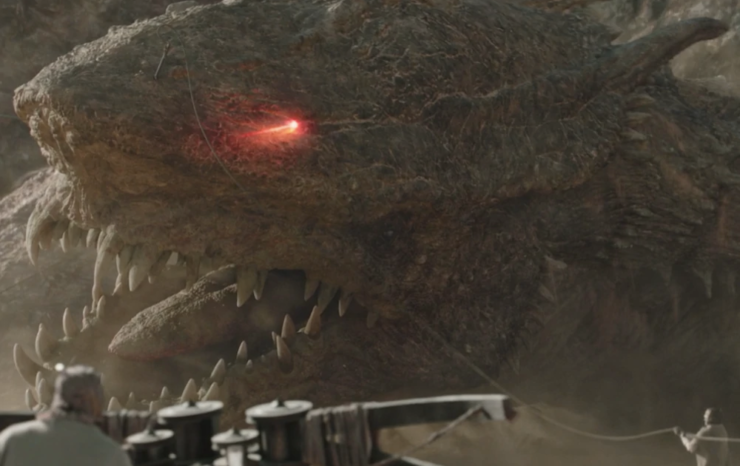Whilst watching an episode of The Mandalorian, I noticed something in the background that was odd enough that I should have taken note of it ages ago: the Star Wars universe sure has a lot of large apex predators for a setting that has been civilized for tens of thousands of years.
This is not the case on present-day Earth. Biodiversity has taken a sharp nosedive in the last 20,000 years. Pretty much any large species that looks tasty, which might have a taste for humans, or lives on land for which we have other purposes in mind has vanished or been greatly reduced in numbers. Because human lifespans are so short, we take the Earth’s depleted state as normal, so are spared angst over all the cool beasts no longer extant.
In the Star Wars universe, the story is very different. When visiting a world in that setting, one should always have a contingency plan for attacks from the local whale-sized predators. What the heck is going on?
Conservationism
Perhaps the civilizations of the Star Wars galaxy decided in antiquity not to impoverish ecosystems. It might be that the Republic and the polities bordering it have had conservationist regulations for millennia. After all, nobody wants to live in a galaxy whose worlds are denuded deserts.
As pleasing as that might be, there is precious little evidence of an excess of prudence in the Star Wars setting. Additionally, it’s hard to believe that a culture incapable of mandating guard rails around the surprisingly deep chasms that appear to be an integral part of the Republic’s architectural design philosophy would be able to frame and enforce conservation regulations for thousands of years.
Incapacity
Perhaps the intelligent beings are incapable of massacring megafauna fast enough to put a serious dent in their numbers? At first glance, this appears implausible. After all, blasters abound. Still, a blaster is only as effective as its owner’s aim and if there’s one thing the Storm Troopers teach us, it is that marksmanship is a skill very unevenly distributed in this setting.
It only takes a few Wild Bills to put a huge dent in megafauna populations, large animals being by their nature comparatively rare, so I am inclined to reject this explanation.
Buy the Book


Fugitive Telemetry
Hunters are only half the story, however. Perhaps the issue isn’t that the hunters are too inept but that tens of thousands of years of natural selection have filtered for megafauna with adaptations to technological predation that permit them to flourish despite blaster-armed trophy hunters. Perhaps most megafauna are exterminated soon after encountering civilized beings, but the exceptions have spread into the empty niches.
There’s some evidence to support this explanation. For example, take the dianoga, the garbage monster in A New Hope. How did such a large beast manage to establish itself on the new Death Star? To quote Wookieepedia:
Over many millennia, dianoga migrated from Vodran by stowing away aboard garbage ships in their microscopic larval forms, and could be commonly found in trash compactors, garbage pits and sewers across the galaxy, living off any present organic matter.
Perhaps the other large megafauna have analogous life cycles, lifeways that permit them to prosper despite civilization’s best efforts to contain them. The Republic’s slapdash approach to safety guidelines could work in the animals’ advantage, the absence of methodically applied and effective quarantines might facilitate the spread of species fortunate enough to be preadapted to survive contact with intelligent beings. Basically, we’re seeing the galactic equivalent of zebra snails and Pablo Escobar’s hippos.
Urbanization
Perhaps megafauna thrive thanks to uneven population distribution and equally uneven economic development. Most of the worlds we see in Star Wars are underdeveloped, low-population backwaters whose inhabitants scrape out marginal lives. Perhaps Coruscant and the other Core worlds act as magnets, their populations and economies growing at the expense of minor worlds, thanks to cheap, fast space travel. Easier to move to the big city to seek one’s fortune than to try to create a big city from the ground up. This seems very reasonable to me, coming as I do from a county with a handful of big cities and vast expanses of considerably less populated territory.
***
A combination of selective adaptation over millennia and uneven development seems plausible enough. But perhaps there are other explanations. Feel free to share them in comments.
In the words of Wikipedia editor TexasAndroid, prolific book reviewer and perennial Darwin Award nominee James Davis Nicoll is of “questionable notability.” His work has appeared in Publishers Weekly and Romantic Times as well as on his own websites, James Nicoll Reviews and Young People Read Old SFF(where he is assisted by editor Karen Lofstrom and web person Adrienne L. Travis). He is a four-time finalist for the Best Fan Writer Hugo Award and is surprisingly flammable.










